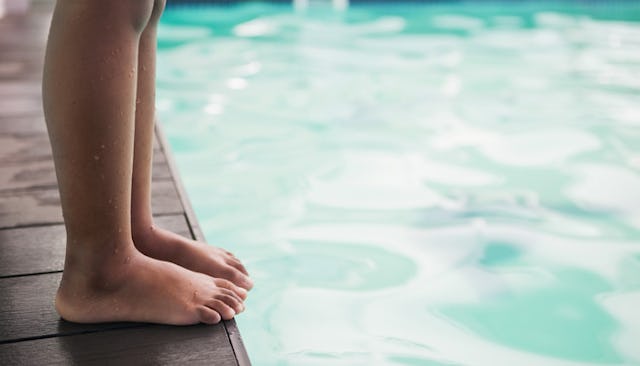Watching My Son Learn To Love The Deep End Of The Pool

I often look back on the way I was taught to swim.
It was in the cold sea off the south of France. There were waves that felt huge to 9-year-old me: a sandy sea floor that I couldn’t touch and weeds that tangled themselves around my shins. There were great, gasping swallows of salty water, stinging eyes and a throat that felt raw for days afterwards. There was my stepfather nearby, who nudged me in deeper and laughed without warmth or kindness.
I was never in danger, but it took a long time before I could swim with joy.
Twenty years later, I watch my son learn to swim.
He is the smallest in his class, with pale white skin that glows in the afternoon light. He wears a bright blue swimming cap with matching goggles and has a laminated swim card on a lanyard around his neck. He tells me every week that he is proud to be here, to be a part of this community of learners. While we wait for the lesson to start, we play I Spy at the edge of the pool: F is for flag, L is for lifejacket or lane marker.
We have been coming for more than a year now. When we first started, he would cry because he was scared. He worried that he would sink. He asked what would happen if he went under and I didn’t notice. I could see that he was imagining the worst. But every week I told him that I was not the only one watching, that we were all watching, and no one would let him sink. I saw him learn to trust the instructors, the gentle young men who eased him into the warm water of our local pool. They were so patient and reassuring with him.
Very slowly, one lesson at a time, they taught him that swimming could be fun.
My son has moved up a group recently. He has dispensed with floats and treasure chests full of plastic toys. There is no more monkey crawling along the wall now. He is onto the serious business of swimming, and it’s not an easy thing. Even in a half-hour lesson, I can see him get tired. But he is in the safest of hands.
When he struggles to kick his legs high enough in the water, the instructors place their arms under his soft belly and hold him up. When his own arms flail around and splash wildly, they calmly correct his movements. They are always close enough to catch him, but far enough to stretch him—it is a magical thing to see.
When the lessons start, I notice other parents pull out their books and phones, enjoying half an hour off duty. But like the very worst soccer mom stereotype, I can’t tear my eyes away from my son. I can’t miss a moment.
Occasionally, he will scan the seats by the side of the pool as he looks for me. When he picks me out, he gives a big wave and a grin, and then his attention returns to the water.
I watch him laugh and chat with the instructors, these sweet, strong men in their late teens and early 20s who just know—partly through instinct and partly through training—that gentle is best. Dylan, Adam, Brendan. Their Australian accents carry across the pool, and I am reminded again how far this experience is from my own.
When it is over and he comes scuttling along the side, teeth chattering, a pink mark along his hairline from the swim cap, I am waiting with a towel to wrap him up and a carton of juice for him to guzzle down.
He tells me that next week, for the last lesson of this term, there will be a treat. They will be allowed to jump in at the deep end for the first time. Even through the cold and the exhaustion, there is an excited look in his eyes.
This is how it should be.
I am so grateful.
This article was originally published on